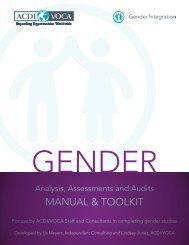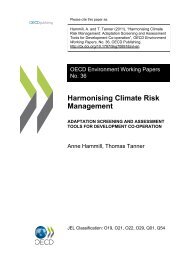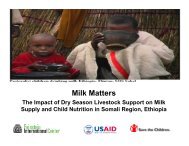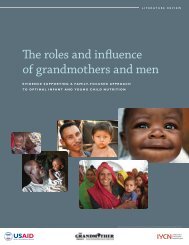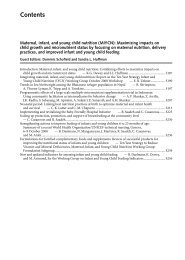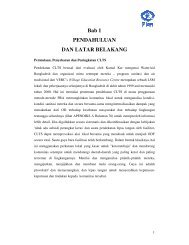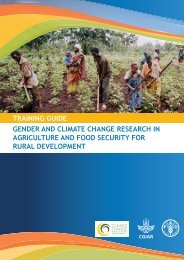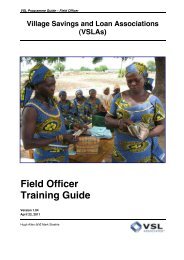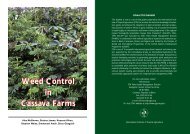WFP Gender Policy - WFP Remote Access Secure Services
WFP Gender Policy - WFP Remote Access Secure Services
WFP Gender Policy - WFP Remote Access Secure Services
- No tags were found...
Create successful ePaper yourself
Turn your PDF publications into a flip-book with our unique Google optimized e-Paper software.
<strong>WFP</strong> <strong>Gender</strong><strong>Policy</strong>Promoting <strong>Gender</strong> Equalityand the Empowerment of Womenin Addressing Food and NutritionChallenges
<strong>WFP</strong> <strong>Gender</strong> <strong>Policy</strong> 2009Women engaged in Wa traditional cultivation of upland rice in Myanmar.
TABLE OF CONTENTS3 EXECUTIVE SUMMARY4 PURPOSE AND SCOPE OF THE POLICY7 RATIONALE9 <strong>WFP</strong>’S EXPERIENCE IN MAINSTREAMINGGENDERAchievements and Challenges10 POLICY FRAMEWORKVisionPrinciples11 GoalsExpected Outcomes12 PRIORITY AREAS OF ACTIONBuilding on Strengths and Addressing the Challenges13 NEW PROGRAMME PRIORITIESAddressing <strong>Gender</strong>-Related Protection Challenges14 Integrating a <strong>Gender</strong> Perspective into HIV/AIDSProgrammesBreaking <strong>Gender</strong> Barriers through Improved Motherand-ChildHealth and Nutrition ProgrammesPromoting <strong>Gender</strong> Equality through <strong>WFP</strong>-SupportedSchool FeedingPromoting Positive <strong>Gender</strong> Relations and SupportingSustainable Livelihoods16 INSTITUTIONAL SUPPORT FOR GENDERMAINSTREAMINGCapacity DevelopmentAccountability17 Advocacy18 <strong>Gender</strong> Mainstreaming in OperationsPartnershipsResearch19 CORPORATE IMPLICATIONS1
<strong>WFP</strong> food distribution in Bangladesh with women registering as food entitlement holders.2
EXECUTIVE SUMMARY“Breaking the cycle of hunger and poverty at its roots begins withwomen. Hunger breeds insecurity and often exacerbates circumstancesthat lead to conflict and crisis, and creates situations where womenand girls are often victims of abuse, rape and violence.In situations of desperate poverty, access to food is power. <strong>WFP</strong> worksin careful and innovative ways to ensure women are empowered —and protected in food distribution and access.”Josette Sheeran, <strong>WFP</strong> Executive Director<strong>Gender</strong> inequality is a major cause and effectof hunger and poverty: it is estimated that60 percent of the world’s chronically hungry peopleare women and girls; 20 percent are children under5. Achieving gender equality remains crucial to reachthe poverty and hunger goals of the MillenniumDeclaration.The Strategic Plan (2008–2011) provides anopportunity to review <strong>WFP</strong>’s gender policy andimprove the way in which gender is addressed in itsprogramming. The positive measures focusing onwomen established by previous <strong>WFP</strong> policies needto continue, but a more holistic approach to genderis required to improve the balance in relationshipsbetween genders and in families.This document sets out a framework formainstreaming gender more fully in <strong>WFP</strong>’s policiesand programmes: it identifies priorities and actionsthat build on <strong>WFP</strong>’s strengths such as its unique fieldpresence and extensive partnerships, incorporatesthe findings of a recent evaluation of its genderpolicy and indicates ways in which <strong>WFP</strong> can workmore constructively to protect women.<strong>WFP</strong> seeks to create an enabling environment forpromoting gender equality and the empowermentof women to support partner countries in addressingfood and nutrition challenges. Ultimately this willincrease the effectiveness and sustainability ofprogrammes addressing poverty and hunger.3
PURPOSE AND SCOPEOF THE POLICY1. <strong>WFP</strong>’s mission can only be achieved ifwomen, men, girls and boys are equal interms of opportunities, access to resourcesand services and participation in decisions. 1With regard to gender, the <strong>WFP</strong> Strategic Plan(2008–2011) highlights the link betweengender and hunger and reaffirms <strong>WFP</strong>’scommitment to work at all levels to ensuregender sensitivity and equality. The newStrategic Plan calls for <strong>WFP</strong> to adapt its toolsto context and meet identified needs in amore appropriate and flexible manner. It alsoprovides an opportunity for <strong>WFP</strong> to review itsgender policy and improve how gender isaddressed in its programming.2. A recent evaluation of <strong>WFP</strong>’s gender policyconcluded that “unlike many United Nationsand donor agencies, <strong>WFP</strong> [has gone] beyondrhetoric to require specific, strategic actionsat the operational level. This resulted inincreased visibility and inclusion of womenand laid strong foundations for gendermainstreaming.” 23. This document builds on the strengths of theformer (2003–2007) gender policy and setsout a framework for the continuedmainstreaming of gender into <strong>WFP</strong>’s policies,operational processes and programmes at alllevels. It identifies priority actions to create anenabling environment to promote gender<strong>WFP</strong> food distribution in Malawi with women and mencollecting food rations together.equality and the empowerment of womenwith a view to increasing the effectiveness1 United Nations Office of the Special Advisor on <strong>Gender</strong> Issues (OSAGI), from Concepts and Definitions section of website: “[<strong>Gender</strong>] equality between women and men […]refers to the equal rights, responsibilities and opportunities of women and men and girls and boys. Equality does not mean that women and men will become the same butthat women’s and men’s rights, responsibilities and opportunities will not depend on whether they are born male or female. <strong>Gender</strong> equality implies that the interests, needsand priorities of both women and men are taken into consideration recognizing the diversity of different groups of women and men. <strong>Gender</strong> equality is not a women’s issue butshould concern and fully engage men as well as women. Equality between women and men is seen both as a human rights issue and as a precondition for, and indicator of,sustainable people-centred development.”2 <strong>WFP</strong>. 2008. “Summary Report of the End-of-Term Evaluation of <strong>WFP</strong>’s <strong>Gender</strong> <strong>Policy</strong> (2003–2007): Enhanced Commitments to Women to Ensure Food Security”(<strong>WFP</strong>/EB.2/2008/6-B).4
and sustainability of programmes addressingextreme poverty and hunger.4. A time-bound corporate action plan withrealistic and measurable targets will bedeveloped providing details of theinstitutional measures to support gendermainstreaming, including resourcerequirements. Country offices will incorporatemeasurable, context based actions into theirwork plans based on gender analysis and inaccordance with the priority areas identifiedin this policy.5
<strong>WFP</strong>-assisted adult literacy programme for women in Afghanistan.6
RATIONALE5. <strong>Gender</strong> inequality is a major cause and effectof hunger and poverty: it is estimated that60 percent of chronically hungry people arewomen and girls; 20 percent are childrenunder 5. 3 Achieving gender equality remainscrucial to reaching the poverty and hungergoals of the Millennium Declaration.6. <strong>WFP</strong>’s past gender policies recognized thisand focus on women’s roles in ensuringhousehold food security. 4 Positive measuresfor women must therefore continue in <strong>WFP</strong>operations but a more holistic approach togender is needed that improves the balancein relationships between genders and infamilies.7. This is partly a result of new challenges andopportunities for gender equality: for example,changes in the dynamics of the HIV/AIDSpandemic have prompted <strong>WFP</strong> to scale up itsresponse and to pay particular attention tomainstreaming a gender dimension intoHIV/AIDS programming. 58. <strong>WFP</strong>’s mission is also becoming increasinglydifficult as a result of climate change, given thehigh proportion of hungry people living indeveloping countries that are affected byclimate change and yet have minimal capacityto adapt. 6 <strong>WFP</strong> is strengthening its capacity torespond to the challenges related to climatechange, including its response to the differentneeds and coping mechanisms of women,men, boys and girls. For example, ininequitable societies, women are morevulnerable to natural disasters than menbecause of socially constructed gender rolesand behaviours that affect their access toresources. 79. High food prices and the current globalfinancial crisis exacerbate vulnerability to foodinsecurity 8 and are negating some gains madein addressing food and nutrition insecurity. Theimplications are different for men and women,so care is needed in designing policies andactions to address the situation.10. Violence against women and girls has escalatedin recent years, resulting in a global call foraction. Much of this violence is occurring inconflict and post-conflict countries where <strong>WFP</strong>has large operations. The Secretary-General’s3 United Nations. 2007. Report of the Secretary-General: Strengthening Efforts to Eradicate Poverty and Hunger, including through the Global Partnership for Development(E/2007/71). New York. According to the Food and Agriculture Organization of the United Nations (FAO) the number of undernourished people as of December 2008 was963 million (see: www.fao.org/news/story/en/item/8836/icode/).4 Research shows that improving the status of women results in positive outcomes for women and their families. Improvements in women’s education have been linked toreductions in child malnutrition rates (Smith, L.C. and Haddad, L. 2000. Explaining Child Malnutrition in Developing Countries: A Cross-Country Analysis. Washington DC,International Food <strong>Policy</strong> Research Institute (IFPRI). Household food security tends to improve if women are given equal access to resources. See IFPRI. 2000. Women:The Key to Food Security: Looking into the Household. Washington DC.5 <strong>WFP</strong>. 2006. Getting Started: HIV, AIDS and <strong>Gender</strong> in <strong>WFP</strong> Programmes. Rome.6 <strong>WFP</strong> and Columbia University. 2008. Climate Change in West Africa: Recommendations for Adaptation and Mitigation. New York.7 Neumayer, E. and Pluemper, T. 2007. The <strong>Gender</strong>ed Nature of Natural Disasters: The Impact of Catastrophic Events on the <strong>Gender</strong> Gap in Life Expectancy, 1981–2002. Availableat http://ssrn.com/abstract=874965.8 FAO. 2008. Soaring Food Prices: Facts, Perspective, Impact and Actions Required (HLC/08/INF/1). Document from the High-Level Conference on World Food Security:The Challenges of Climate Change and Bioenergy. 3 5 June 2008. Rome.7
<strong>WFP</strong>-supported bakery project in Tajikistan.study of violence against women sets out itsforms, consequences and costs. 911. In recognition of the need to expedite theachievement of gender equality and theempowerment of women, the United Nationsadopted a gender mainstreaming policy andstrategy in 2006, 10 which provides a commonframework for the United Nations system.9 United Nations. 2006. Report of the Secretary-General: In-Depth Study on all Forms of Violence against Women (A/61/122). New York.10 United Nations. 2006. United Nations System-Wide <strong>Policy</strong> on <strong>Gender</strong> Equality and the Empowerment of Women: Focusing on Results and Impact (CEB/2006/2). New York.8
<strong>WFP</strong>’S EXPERIENCEIN MAINSTREAMING GENDERAChiEvEmENts ANd ChAllENGEs12. <strong>WFP</strong>’s past gender policies have resulted inseveral achievements:i) The focus on women and girls has giventhem visibility as beneficiaries andcontributors to household food security. 2ii) Women’s access to food has increasedconsiderably as a result of making womenthe holders of food entitlements.iii) Women’s equal participation in decisionmakingbodies has been promoted byestablishing a 50 percent minimum for theirparticipation in food committees.iv) Girls’ access to education has beenenhanced by extra rations to encourageparents to send girls to school.v) Women now have greater access to trainingthrough food-for-training (FFT) schemes.vi) The collection of sex-disaggregated datahas become routine.13. There are, however, challenges still to beaddressed:i) There is evidence that increasing therepresentation of women in food-relatedbodies does not automatically result inincreased participation in decision making.ii) Issuing ration cards in women’s names doesnot necessarily give them control overhousehold rations because control isdetermined by the capacity to negotiateand decide the use of food. 11iii) A “one-size-fits-all” approach to theiv)Enhanced Commitments to Women (ECW)may have limited field-based innovationand reduced the impetus to carry outgender analysis to adapt programmes totheir context.Limited understanding of gender issuesamong field staff has sometimes led themto perceive gender issues as relating only towomen. 12 More research and improvementsin programme design are necessary.14. Achieving gender balance in staffing remains achallenge, particularly in managerial positions. 2This is addressed in <strong>WFP</strong>’s human resourcestrategy. 13<strong>WFP</strong>-supported school feeding in the mountainareas of Bhutan.11 See <strong>WFP</strong> case studies to assess the implementation of women’s control of food in relief food distributions (ECW IV) and participation in decision-making (ECW V) in Colombia,Indonesia, Kenya, Rwanda, Sierra Leone and Zambia, June–September 2004.12 In a survey in 2007, the gender focal points also identified inadequate funding and capacity and limited practical tools for gender mainstreaming as challenges forimplementing the gender policy.13 “Preparing for Tomorrow Today: Strategy for Managing and Developing Human Resources (2008–2011)” (<strong>WFP</strong>/EB.2/2008/4-C/Corr.1)9
POLICY FRAMEWORKvisioN15. To create an enabling environment in <strong>WFP</strong> forpromoting gender equality and theempowerment of women reflected in policies,programmes and actions that support partnercountries in addressing food and nutritionchallenges.PriNCiPlEs16. <strong>Gender</strong> equality is not merely socially desirable: itis critical to the reduction of poverty and hunger 14and therefore linked to the achievement of <strong>WFP</strong>’sStrategic Objectives. <strong>WFP</strong> will continue to seekopportunities to promote gender equality andthe empowerment of women to fulfil its mandatein food and nutrition security.<strong>WFP</strong>-supported adult literacy programmefor indigenous women in Bolivia.17. This gender policy builds on previous genderpolicies, and is guided by:• the <strong>WFP</strong> Strategic Plan (2008–2011), whichemphasizes <strong>WFP</strong>’s role in supportingcountries in addressing hunger andundernutrition;• the principles of the United Nations policyand strategy on gender mainstreaming, 15Resolution 2006/36 of the Economic andSocial Council and other norms andstandards; 16• the core values of humanity, impartiality,neutrality and respect in <strong>WFP</strong>’s humanitarianprinciples; 17• the principle of “do no harm”, which is thecommitment to prevent actions that causeharm to any beneficiary: 18 it may includeensuring that distribution sites are safe andtaking care not to overburden women orexpose them to violence, sexual exploitationor abuse; and• the principles of the gender anddevelopment approach, whichencompasses the social, economic, politicaland cultural forces that determine how menand women might benefit from and controlresources and activities; the approachfocuses on gender relations with a view toachieving sustainable improvements in thestatus of women.14 Morrison, A., Raju, D. and Sinha, N. 2008. <strong>Gender</strong> Equality is Good for the Poor. Poverty in Focus, 13: 16 17.15 United Nations. 2006. United Nations System-Wide <strong>Policy</strong> on <strong>Gender</strong> Equality and the Empowerment of Women: Focusing on Results and Impact (CEB/2006/2). New York. The mainelements are: i) accountability; ii) results-based management; iii) oversight functions – monitoring and evaluation (M&E), audit and reporting; iv) human and financial resources;v) capacity development; and (vi) coherence, coordination, knowledge and information management.16 Convention on the Elimination of All Forms of Discrimination against Women (1979); Beijing Declaration and Platform for Action (1995); United Nations Security CouncilResolutions 1325 and 1820 on women and peace and security (2000; 2008); The Millennium Declaration (2000); the Declaration of the World Food Summit; five years later(2002); the Secretary-General’s bulletins/directives on sexual exploitation and abuse (2003).17 “Humanitarian Principles” (<strong>WFP</strong>/EB.A/2004/5-C), p. 8.18 CDA Collaborative Learning Projects. 2004. The Do No Harm Handbook. The Framework for Analyzing the Impact of Assistance on Conflict, p. 19. Cambridge, MA, USA.10
18. The development of this <strong>WFP</strong> gender policy hasbeen informed by the evaluation of <strong>WFP</strong>’sgender policy (2003–2007), consultations withpartners and field staff, desk reviews of partners’policies, ECW baseline and follow-up surveys. 19A returnee with his children in a temporary resettlementcamp in Afghanistan.GoAls19. The goals are:• to strengthen and maintain an institutionalenvironment that supports and encouragesgender mainstreaming;• to improve the effectiveness andsustainability of <strong>WFP</strong> programmesaddressing hunger in partner countries; and• to promote the integration of a genderperspective into the food and nutritionpolicies, programmes and projects ofpartner countries and cooperating partners.ExPECtEd outComEs20. The expected outcomes are:• increased knowledge and skills among <strong>WFP</strong>staff for addressing gender in policydevelopment and programming;• improved and sustained gendermainstreaming in <strong>WFP</strong> programmes andactivities; and• increased capacity in partner countries toincorporate a gender perspective into foodand nutrition policies, plans and projects.21. Targeted actions 20 and gender mainstreaming 21will be applied to achieve the expectedoutcomes. Targeted actions will be carried outin the context of <strong>WFP</strong>’s field-level programmingon the basis of gender analysis; gender will bemainstreamed at the programme andinstitutional levels. Because women are oftendisadvantaged, these actions will more oftenfavour them. This does not preclude action formen and boys if required.19 <strong>WFP</strong>. 2007. <strong>Gender</strong> Focal Point Survey. Desk Review of the ECW Implementation and Views from <strong>WFP</strong> <strong>Gender</strong> Focal Points/Teams. Rome.20 Inter-Agency Standing Committee (IASC). 2006. <strong>Gender</strong> Handbook in Humanitarian Action. New York. See p. 3: Targeted actions “should compensate for the consequences ofgender-based inequality such as the long-term deprivation of rights to education or health care. This is important as in many situations women and girls are moredisadvantaged than men and boys […] but there are a number of situations where boys or men will be targeted for action, for example when boys are the target of recruitmentfor armed conflict”.21 United Nations. 1999. (A/52/3/Rev.1), p. 24: “Mainstreaming a gender perspective is the process of assessing the implications for women and men of any planned action […] inall areas and at all levels. It is a strategy for making women’s as well as men’s concerns and experiences an integral dimension of […] policies and programmes […] so thatwomen and men benefit equally and inequality is not perpetuated. The ultimate goal is to achieve gender equality.”11
PRIORITY AREAS OF ACTIONBuildiNG oN strENGths ANd AddrEssiNGthE ChAllENGEs22. <strong>WFP</strong> has a strong base from which to promotegender equality and the empowerment ofwomen: the focus on women in its previouspolicies has increased awareness of and respectfor women as partners and beneficiaries. 223. <strong>WFP</strong> therefore commits itself to:• continue providing food assistance forpregnant and lactating women, childrenunder 5 and adolescent girls;• continue making women the foodentitlement holders and ensuring that theyare not put at risk of abuse or violenceas a result of this policy;• continue facilitating the participation ofwomen in food distribution committees; and• continue improving access to educationand reducing the gender gap in primaryand secondary education, using take-homerations as an incentive.24. The gender policy evaluation identified keyissues to guide this new policy, includingi) restoring a gender mainstreaming mandate;ii) reorienting the institutional approach toenable context-led approaches; and iii)marshalling operational resources.25. <strong>WFP</strong> will therefore establish new programmepriorities and institutional support mechanismsthat will provide the enabling environment forsuccessful gender mainstreaming.A <strong>WFP</strong> beneficiary in Cambodia shares household chores with his wife who weaves silk to support the family.12
NEW PROGRAMME PRIORITIES26. The new programme priorities incorporate agender-sensitive perspective and take intoaccount the different contexts in which <strong>WFP</strong>operates, ranging from complex emergenciesto more stable conditions.Otash refugee camp in South Darfur, Sudan.AddrEssiNG GENdEr-rElAtEdProtECtioN ChAllENGEs27. <strong>WFP</strong> will continue to promote the protection ofits target population and staff members inaccordance with the Secretary-General’s specialmeasures on sexual exploitation and abuse, 22and Security Council Resolutions 1325 and1820 on women and peace and security.28. <strong>WFP</strong> will work to prevent violence againstwomen, girls and children in its operations. Incomplex emergencies it will seek to do thefollowing:• Reduce the burden on, and improve thesafety of, women and girls in camps.Firewood is often collected exclusively bywomen and girls, 23 who may walk longdistances outside the camps with heavyloads and at personal risk. As part of interagencyefforts, in camps <strong>WFP</strong> will: i) mobilizeresources to provide fuel-efficient stoves tothe most vulnerable women; ii) use its foodassistance to support income generatingactivities for women and girls; iii) supportthe creation of safe and private spaces forwomen and girls; and iv) facilitate theformation of women’s support groups incamps to enable women to make decisionsand be heard concerning food and nutritionsecurity.• Identify additional opportunities in <strong>WFP</strong>operations to improve the protection ofwomen and girls. This will include: i) usingfood assistance to engage men and boys tofoster understanding of the links betweengender inequality and hunger, involve themin activities to protect women and childrenfrom violence and reduce burdens onwomen, and share childcare responsibilities;ii) making <strong>WFP</strong> distribution sites safe forwomen and girls; and iii) using <strong>WFP</strong>’s fieldpresence and national staff to encouragelocal initiatives aimed at ending violenceagainst women and girls.22 United Nations Secretariat. 2003. Secretary-General’s Bulletin: Special measures for protection from sexual exploitation and sexual abuse (ST/SGB/2003/13). New York.23 Women’s Commission for Refugee Women and Children. 2006. Beyond Firewood: Fuel Alternatives and Protection Strategies for Displaced Women and Girls. New York. According tothis study, cooking fuel is rarely provided by the humanitarian community; it is even rarer for men to collect wood.13
iNtEGrAtiNG A GENdEr PErsPECtivE iNtohiv/Aids ProGrAmmEs29. Addressing gender inequality is fundamentalto reducing the vulnerability of women andgirls to HIV and AIDS. <strong>WFP</strong> will continue tosupport an inter-agency response to thepandemic, and will seek to: i) use its foodassistance to increase awareness of the linksbetween HIV/AIDS, gender inequality, genderbasedviolence and food insecurity; and ii)work with partners to promote theinvolvement of men and boys in HIV/AIDSprevention, mitigation, treatment, supportand caregiving. 24BrEAkiNG GENdEr BArriErs throuGhimProvEd mothEr-ANd-Child hEAlthANd NutritioN ProGrAmmEs30. Mother-and-child health and nutrition (MCHN)programmes can break gender barriers inchildcare by including men and boys innutrition and health education activities. <strong>WFP</strong>will continue to collaborate with partners to:i) provide an essential package of non-foodinterventions for pregnant and lactatingwomen, children under 5 and adolescent girls;ii) involve men and boys in activities to raiseawareness of MCHN, improve their knowledgeof and commitment to maintaining thenutrition and health of mothers and children,and increase their participation in childcare;and iii) promote the development and use ofready-to-use foods that meet nutritional needsand save time and fuel, especially in camps.PromotiNG GENdEr EquAlity throuGh<strong>WFP</strong>-suPPortEd sChool FEEdiNG31. There is evidence of the positive impact ofschool feeding on addressing the gender gapin education. <strong>WFP</strong> will therefore collaboratewith partners 25 to further use school feeding asan entry point to promote gender equalityduring children’s formative years. Innovativelearning and advocacy methods will bepromoted to address, for example, theprevention of sexual and gender-basedviolence.PromotiNG PositivE GENdEr rElAtioNsANd suPPortiNG sustAiNABlElivElihoodsFood for Work and Food for Training32. Food-for-work (FFW) and FFT programmes willbe designed to take into account the differentneeds of women, men, young people and theelderly. <strong>WFP</strong> will ensure: i) that women andmen participate equally in identifying FFW andFFT activities on the basis of their differentneeds and priorities; ii) that women and menhave equal access to benefits through FFWand FFT programmes that are designed in aparticipatory process; support systems such as24 For example in Zimbabwe, the Rome-based-care programme supported by <strong>WFP</strong> and the NGO Africare has a strong focus on involving men by training them as caregivers. Thisinitiative has challenged the myth that men cannot provide care for the sick and it has reduced the burden on women of providing care.25 The school feeding “Essential Package” is a <strong>WFP</strong>–UNICEF collaborative effort that includes promoting girls’ education and can be expanded to include other gender-basedinterventions.14
<strong>WFP</strong> school meals and take-home rationspromote girls’ education in Lao.childcare will be considered in the design toimprove women’s access to the benefits; andiii) that a monitoring system is put in place toascertain whether women are empowered interms of decision making and of benefitingfrom <strong>WFP</strong> assistance to improve theirlivelihoods; the system should includequalitative data.Cash Transfer and Voucher Programmesand Cash for Work33. Cash transfer and voucher programmes andcash-for-work (CFW) programmes, will bedesigned that ensure that women benefitequally with men, without negative implications.<strong>WFP</strong> will ensure that: i) cash transfer and voucherprogrammes take into account the needs ofwomen and children, including food andnutrition security and the potential for domesticviolence over the control of cash or vouchers;and ii) a monitoring system is put in place toascertain whether women are empowered bycash transfer and voucher programmes throughdecision-making and improved livelihoods.Purchase for Progress34. Purchase for Progress (P4P) projects will takeinto account the inequality of women and menin access to farming inputs, transports, marketsand returns. <strong>WFP</strong> will ensure: i) adequaterepresentation of women farmers byestablishing minimum targets for theirparticipation in line with country contexts; thiswill include working with traders and farmers’associations to ensure that women are equitablyrepresented in management positions and thatwomen farmers benefit directly from cashpayments for their produce; and ii) that amonitoring, evaluation and reporting system isin place at the country level to track women’sparticipation.15
INSTITUTIONAL SUPPORT FORGENDER MAINSTREAMINGBeneficiaries’ consultation in Sudan.35. <strong>WFP</strong> will establish specific institutional measuresto support the incorporation of a genderperspective in its operations.CAPACity dEvEloPmENt36. <strong>WFP</strong> will ensure that staff members develop thecapacity to mainstream gender in their work,including carrying out gender analyses. Acomprehensive capacity development plan willbe implemented to address the capacities andcompetencies of staff for mainstreaminggender. 26 This will include utilizing trainingopportunities created through inter-agencymechanisms and the efforts of partners.37. <strong>WFP</strong>, as part of the United Nations country teamsand through its involvement in PovertyReduction Strategy processes, will advocatefor — and support governments andcooperating partners to strengthen theircapacity for — incorporating a genderperspective in their national food and nutritionplans, policies and programmes.ACCouNtABility38. <strong>WFP</strong> will: i) improve its accountability systemsand revise its accountability tools to incorporategender perspectives into workplans, riskmanagementprofiles, monitoring and26 For example, gender-sensitive content will be incorporated into the training for country directors in 2009.16
<strong>WFP</strong>-supported HIV/AIDS awareness programme for adolescent girls in Bangladesh.evaluation tools, the Indicator Compendium, thePerformance and Competency Enhancementprogramme and the Strategic ResultsFramework; senior managers will provideleadership and have primary responsibility forimplementing this gender policy; ii) promoteaccountability for gender mainstreamingamong its partners through field-levelagreements and Memoranda of Understanding;iii) strengthen its monitoring and evaluationsystems to measure and report on progress inmainstreaming gender; and iv) enforce andmonitor its policy on sexual harassment andabuse of power, including its executivedirectives on sexual exploitation and abusein accordance with the United Nations’ zerotolerance policy on sexual exploitationand abuse.AdvoCACy39. <strong>WFP</strong>’s extensive field presence and network ofpartners provide opportunities for advocacy atdifferent levels. <strong>WFP</strong> will collaborate with itspartners to: i) raise awareness of theimportance of promoting gender equality andempowering women to achieve sustainablefood and nutrition security; and ii) developa communication and advocacy strategy fora better understanding of the links between17
<strong>WFP</strong> works withpartners to promotegender equality andthe empowerment ofwomen for theachievement ofsustainable food andnutrition security.gender inequality, hunger and the sharingof responsibilities.40. <strong>WFP</strong> will harness the extensive experience of itsgender focal points by transforming them into agender advocacy network.GENdEr mAiNstrEAmiNG iN oPErAtioNs41. <strong>WFP</strong>’s extensive field presence also provides theopportunity to use knowledge of localconditions to design and implementprogrammes that are appropriate and sensitiveto local cultures.42. <strong>WFP</strong> will make it mandatory to incorporate agender perspective into operations at all stagesof a project cycle. <strong>WFP</strong> assessment tools will berevised accordingly to support this process.43. To further help country offices to mainstreamgender, <strong>WFP</strong> will: i) launch a <strong>Gender</strong> FriendlyCountry Office Initiative, whereby country officeswill be rewarded for compliance with themeasures set out in this policy; and ii) mobilizeresources to establish a <strong>Gender</strong> InnovationsFund to help country offices implementinnovative activities that promote genderequality and the empowerment of women.PArtNErshiPs44. <strong>WFP</strong> will continue to strengthen partnerships atall levels, including working at the inter agencylevel to address gender issues and promoteknowledge sharing.45. <strong>WFP</strong> will work with partners – governments;international, regional and local organizations;and communities – to mobilize complementaryresources, including expertise. 27rEsEArCh46. <strong>WFP</strong> will collaborate with academic institutionson research to improve its policies andprogrammes and will collaborate with partnersin assessing the impacts of its interventions.27 For example the GenCap Project, administered by the Norwegian Refugee Council provides gender standby capacity to United Nations agencies using a pool of genderadvisers who can be deployed on short notice during emergency situations.18
CORPORATE IMPLICATIONS47. Implementing this policy will entail changesin some core processes and may require theestablishment of new ones, which will haveimplications for human and financialresources. <strong>WFP</strong> will therefore invest inspecialist staff and capacity development andwill, within its funding capacity, provideresources for gender mainstreaming. <strong>WFP</strong> willalso seek extra-budgetary resources toaddress funding gaps.A family in front of their new homein a resettlement village for refugeesassisted by <strong>WFP</strong> in West Timor.19
Acronyms used in the document:CFWcash for workECWEnhanced Commitments to WomenFAOFood and Agriculture Organization of the United NationsFFTfood for trainingFFWfood for workIASCInter-Agency Standing CommitteeHIV/AIDShuman immunodeficiency virus/acquired immune deficiency syndromeIFPRIInternational Food <strong>Policy</strong> Research InstituteMCHNmother-and-child health and nutritionOSAGIOffice of the Special Advisor on <strong>Gender</strong> IssuesP4PPurchase for ProgressPhoto creditsCover shot: Sudan, <strong>WFP</strong>/Simon Crittle; Page 1: Myanmar, <strong>WFP</strong>/Than Tin Lily; Page 2: Bangladesh, <strong>WFP</strong>/Shehzad Noorani; Page 4: Malawi, <strong>WFP</strong>/AntonelloNusca; Page 6: Afghanistan, <strong>WFP</strong>/Susannah Nicol; Page 8: Tajikistan, <strong>WFP</strong>/Shehzad Noorani; Page 9: Bhutan, <strong>WFP</strong>/Photolibrary; Page 10: Bolivia,<strong>WFP</strong>/Alejandro Chicheri; Page 11: Afghanistan, UNHCR/Roger Arnold; Page 12: Cambodia, <strong>WFP</strong>/Jim Holmes; Page 13: Sudan, <strong>WFP</strong>/Emilia Casella; Page 15:Lao People’S Democratic Republic, <strong>WFP</strong>/Tom Greenwood; Page 16: Sudan, <strong>WFP</strong>/Liz Gilbert; Page 17: Bangladesh, <strong>WFP</strong>/Shehzad Noorani; Page 18: <strong>WFP</strong>/ReinSkullerud; Page 19: West Timor, <strong>WFP</strong>/Barry Came; Page 21: Niger, <strong>WFP</strong>/Marcus Prior.20
Cooking is not only a woman’s role. A man preparing a meal in Niger.21



